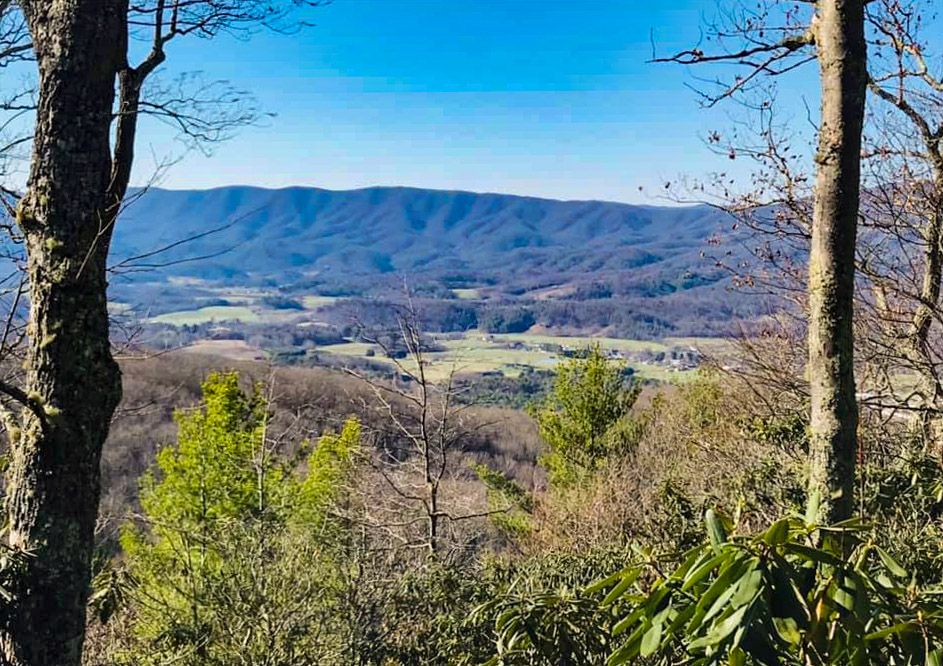
Taken from Lofty Top View along trail 20 in Doe Mountain Recreation Area. Photo by Tate Davis.
Sitting in the extreme northeastern part of Tennessee, Johnson County looks like a finger directing people into Virginia or North Carolina or points east. But it really ought to be pointing inward, as if to say “Don’t pass me by, there is plenty to see and do right here.” For instance, the Doe Mountain Recreation Area (DMRA). Never heard of it? Well, the Tennessee governor’s office has in Nashville. The story behind Doe Mountain’s recent development, the work being done to make it an even-more-attractive destination, as well as its natural beauty, enabled Johnson County to become the first county to win the 2020 Governor’s Environmental Stewardship Awards (GESA) new Natural Resources category, which recognizes groups that go “above and beyond” when it comes to protecting or improving the environment.
It is an award Johnson County richly deserved. Its Doe Mountain Recreation Area is one of the largest remaining stretches of privately-owned woodland in the Appalachians, encompassing 8,600 acres. The centerpiece of Johnson County’s Adventure Tourism District, it offers more than 60 miles of multi-use trails for hiking, plus controversial but popular horseback and Sierra Club-discouraged motorized off-road vehicle (ORV) riding.
No matter how you traverse the trails, you can come upon as many as 40 rare species of plants and animals, as well as a number of places to stop and take in the breathtaking scenery of both the adjacent ridges and the valleys just below. Grouse Ridge, for instance, offers a wooden platform overlooking Doe Valley. But a more comprehensive and historic experience can be found at the Kettlefoot Fire Lookout Tower. Built in 1936 by the Civilian Conservation Corps and recently restored with a grant from the Appalachian Regional Commission, the 60-foot structure sits at the very top of Doe Mountain’s 3,889 feet. If you have the leg and lung power to climb the staircase, you will be rewarded with views into three states — Grandfather Mountain in North Carolina, Whitetop Mountain in Virginia, and Watauga Lake and Roan Mountain in Tennessee.
The story behind DMRA is every bit as captivating as the scenery. Back in 2005, all 8,600 acres were purchased by a developer, who planned to populate it with homes. But then serendipity came to nature’s defense. Before any earth could be moved, the developer declared bankruptcy. His adversity proved to be good fortune for the rest of us when in 2012 The Nature Conservancy purchased the land for $8.8 million, then transferred the title to the State of Tennessee within a matter of days. In November of 2013, DMRA was opened to the public for multiple-use recreation as well as natural resource protection.
The GESAs, co-presented by the Governor and the Tennessee Department of Environment and Conservation (TDEC), are considered to be the most prestigious environmental and conservation awards in Tennessee. Established in 1986, they are designed to shine a spotlight on those whose work makes outstanding contributions to the preservation and protection of community and state natural resources, in addition to increasing the knowledge and awareness of effective conservation and environmental practices and projects. A nine-person panel, representing the agricultural, conservation, forestry, environmental and academic professions, judges the nominees, looking at on-the-ground environmental achievement, innovation, transferability, partnerships, and public education.
The awards also encourage leadership by example, and the DMRA has certainly embraced that role wholeheartedly. According to Executive Director Tate Davis, major improvements are being readied. Backed by a million-dollar grant from the Federal Recreational Trails Program, a comprehensive assessment is expected to lead to the addition of more trails and viewpoints, the improvement of many of the current trails, and an enhancement of the trailhead at Harbin Hill. By adding extra trails, it is hoped that more hikers will include Doe Mountain — often called “the Backbone of Johnson County” — in their bucket list, along with regional staples like the Great Smoky Mountains National Park, the Appalachian Trail, and the Iron Mountain Trail.
When he mounted the podium to declare this year’s winners, Tennessee Governor Bill Lee stated that, “These awards show that responsible environmental stewardship is happening across our state.” Mike Taylor, Mayor of Johnson County, could not agree more. The County’s partnership with the Doe Mountain Recreation Area, he said, maintains “an environmental standard that seeks to preserve the integrity of the mountain… We will always strive to balance tourism with protecting our county’s greatest natural resources.”
Winning the Natural Resources 2020 GESA would seem to indicate that Johnson County’s finger-like shape is also pointing the way for Tennessee’s other 94 counties.
Contact Marshall at msadesman@gmail.com
